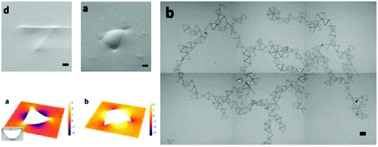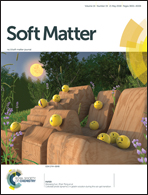Capillary-driven binding of thin triangular prisms at fluid interfaces†
Abstract
We observe capillary-driven binding between thin, equilateral triangular prisms at a flat air–water interface. The edge length of the equilateral triangle face is 120 μm, and the thickness of the prism is varied between 2 and 20 μm. For thickness to length (T/L) ratios of 1/10 or less, pairs of triangles preferentially bind in either tip-to-tip or tip-to-midpoint edge configurations; for pairs of prisms of thickness T/L = 1/5, the tip of one triangle binds to any position along the other triangle's edge. The distinct binding configurations for small T/L ratios result from physical bowing of the prisms, a property that arises during their fabrication. When bowed prisms are placed at the air–water interface, two distinct polarity states arise: prisms either sit with their center of mass above or below the interface. The interface pins to the edge of the prism's concave face, resulting in an interface profile that is similar to that of a capillary hexapole, but with important deviations close to the prism that enable directed binding. We present corresponding theoretical and numerical analysis of the capillary interactions between these prisms and show how prism bowing and contact-line pinning yield a capillary hexapole-like interaction that results in the two sets of distinct, highly-directional binding events. Prisms of all T/L ratios self-assemble into space-spanning open networks; the results suggest design parameters for the fabrication of building blocks of ordered open structures such as the Kagome lattice.



 Please wait while we load your content...
Please wait while we load your content...
